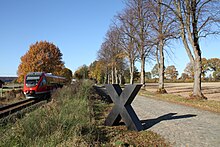Expedition Münsterland
| Expedition Münsterland | |
|---|---|

|
|
| founding | 2010 |
| place | Muenster |
| state | North Rhine-Westphalia |
| country | Germany |
| management | Wilhelm Bauhus |
| Employee | 5 |
| Website | www.expedition-muensterland.de |
Expedition Münsterland is an initiative of the Westphalian Wilhelms University of Münster in the field of science communication . It presents scientific topics, especially those with a regional reference to the Münsterland, in public and encourages citizens to engage with science.
overview
"Expedition Münsterland" was launched by the University of Münster in 2010 and developed by its Research Transfer Office (AFO). Daily events, exhibitions and projects are intended to lead students and citizens, but also companies, municipalities, clubs, associations and schools to science locations. In the spirit of Citizen Science , the exchange and scientific cooperation with the citizens of the Münsterland are to be intensified and joint activities expanded. The aim is a dialogue between science and society.
Scientists and students prepare scientific topics in a generally understandable way and present them in the region. By exchanging ideas with the population, they in turn have the opportunity to get to know the region. Children should be familiarized with the academic environment at an early stage, high school graduates should come into contact with students, and adults should have access to the world of science. Not only academics do science, but laypeople become active as citizen scientists on site, for example in collecting data on certain topics or inspecting private, often scientifically interesting archives.
Constant offers
In cooperation with the Ascheberg Tourist Information Office , the Münsterland expedition organizes " Strontianite round flights". Strontianite mining in southern Münsterland triggered a real gold rush atmosphere in the 19th century. Today, the few remnants of mining, spoil heaps from the pits, so-called marl heaps, can best be seen from the air. Sightseeing flights with an ultralight aircraft provide an overview of the landscape and its history.
Together with the ADFC district association Münster / Münsterland, the Expedition Münsterland offers regular guided bike tours along the Münsterschen Aa .
Multi-year projects
The Expedition Münsterland also organizes multi-year, third-party funded events with a wide variety of project partners.
Cultural traverse Berkel
The Berkel , which rises in the Münsterland and flows from Billerbeck to Zutphen (Netherlands), was navigable in earlier times and thus enabled the transfer of important goods and forms of social exchange. This function as a “cultural-historical bridge” is to be rekindled through new ideas with the participation of local actors as well as cultural workers and researchers from the regions. Corresponding projects are to be implemented and, based on the respective expedition location, new learning communities are to be created. In 2015 and 2016, events on the topics of culture, religion, war and peace, trade and change as well as ecology will take place in the regions of the Berkel area, which will allow the region to be explored from multiple perspectives. The “Kulturtraverse Berkel” project is supported by the NRW funding program “Regional Cultural Policy”.
Expedition to peace
2014 marked the centenary of the start of the First World War , a military conflict whose potential for violence was unprecedented at the time. In the “Expedition to Peace”, the Münsterland expedition tried together with the Department of History, Chair for Modern and Contemporary History, the WWU through a targeted combination of art and science, to address an audience interested in the topic inside and outside the university. The approach should differ from the conventional historical-political and cultural remembrance implementations, the existing and often updated "large narratives" regionally and with reference to specific places of knowledge should be made tangible and reflected by artistic interpretations. In May 2016, a bike tour guide through Münsteraner Geschichte (n) will be published, referring to the project .
X_locations
In a project that has existed since 2011, special locations in the Münsterland are marked with a 1.80 meter black wooden x. It is intended to draw the viewer's attention to places that are not visible, either because they were deliberately created that way, or because they have been forgotten or have been weathered. The x stands for the mysterious, dark, unexplained, enigmatic or disappeared in the places it has marked and is intended to draw attention to them and the historical events and contexts surrounding them. One example is a cemetery established during the First World War, the only "living" reference to the former prisoner-of-war camp Haus Spital . An exhibition with photographs provides more information. The "X_Orte" were supported by the NRW funding program "Regional Cultural Policy".
literature
- Julia Gottschick: Expedition Münsterland. An encounter between science and the region , published by Aschendorff Verlag, Münster 2013, ISBN 978-3-402-13028-5 .
- Dr. Wilhelm Bauhus: Durch Münsteraner Geschichte (n) , published by Verlag Monsenstein and Vannerdat, Münster 2015, in print.


